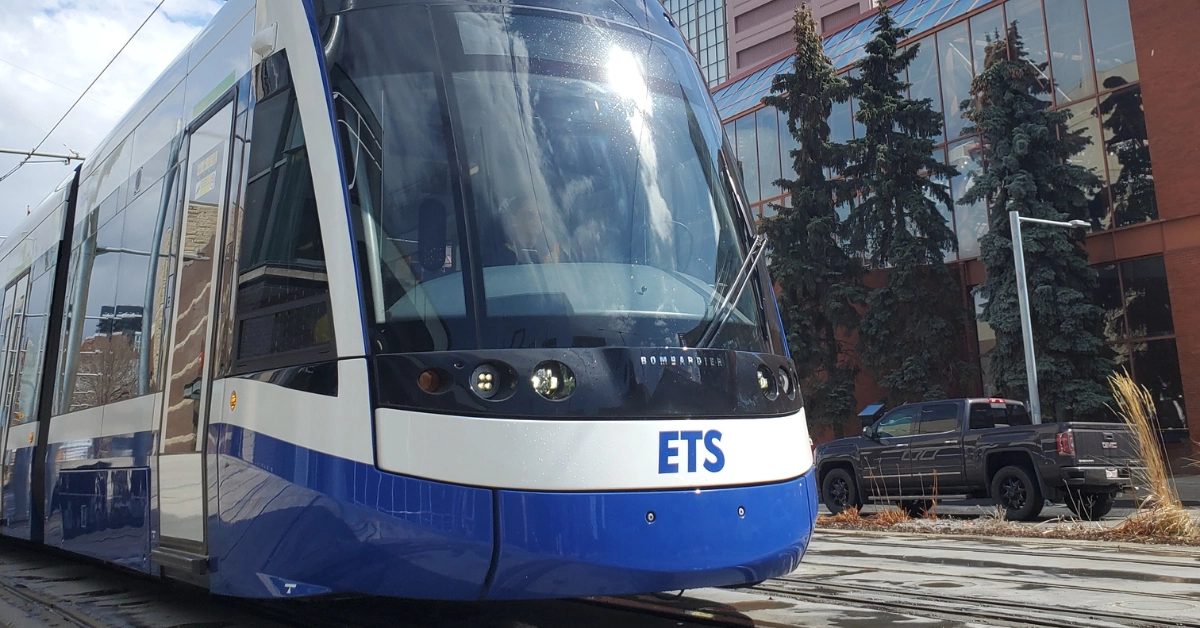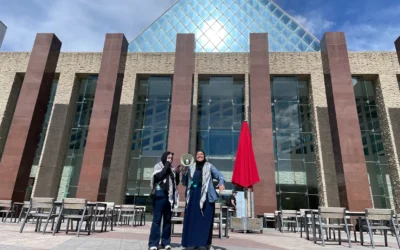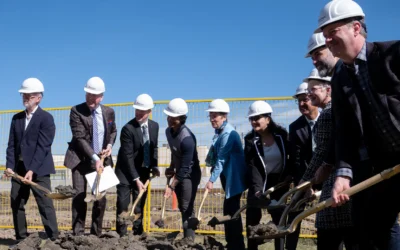Proof that Edmonton is always worth investing in
Hundreds of Edmontonians woke up well before 5 a.m. on Nov. 4 for the opening day of Edmonton’s first separate train line since 1978. I was one of those people.
We rode at dawn. Most gathered at the 102nd Street station less than five blocks from MacEwan’s City Centre Campus where the very first train was set to depart at 5:15 a.m. When I arrived just before 5 a.m., there were so many people that they almost spilled off the platform and onto the tracks.
Local Edmonton superfans Troy Pavlek and Mike Kunicki (as well as others) organized a launch party for the Valley Line with cake, coffee, and music (“Crazy Train” by Ozzy Osbourne). Just before the first train arrived, Pavlek busted out a large red ribbon and a pair of comically large scissors before handing them to Sam Clark who had the honour of cutting the ribbon for the new train.
The air was electric. Although it was a long time coming, and this particular train line was roughly three years late, the energy was still full of a mutual love for the city. Amongst the crowd was a slurry of city staff, ETS transit employees, transit nerds, and nearly all of the city councillors. When the first train car pulled into the station, the crowd erupted into cheers. It was glorious.
The people chanted in unison, “LRT! LRT! LRT!”
All jokes aside, the Valley Line was worth the wait. But, it has been quite the wait for Edmonton to improve its transit game.
The journey started in December of 2009 when City Hall began putting together a plan for a new light rail train line that would connect Edmonton’s southeast corner to the heart of the city. Funds for preliminary engineering were approved in 2011. In February of 2012, plans for the official line were approved.
The city provided $800 million, the federal government invested $250 million, and the provincial government funded $235 million. But, there was still a $515 million funding gap that delayed the project until March 2014. Construction finally began in 2016 once all land procurement, plans, funds, and construction had been fully fleshed out.
The line was originally scheduled to be completed by 2020, but it was delayed three times. The first delay was because a segment of the line was behind schedule — 2019’s frequent summer rain delayed the construction. The next delay was due to a large car-sized piece of concrete being found underneath the north beam of the line’s Tawatinâ Bridge.
And then, in July 2022, an inspection revealed that cracks were forming along 45 supporting pillars for the elevated portion of the line. Later analysis determined the cracks were due to inadequate rebar in the concrete.
Finally, this October,the city announced the official opening day for the new line. It was a full three years later than the original plan. The delays were reminiscent of other city projects such as the Walterdale Bridge replacement project which took two additional years to complete due to issues with contractors.
But, as I boarded the train, I felt like I was experiencing an utter victory for the city.
Edmonton’s population has boomed in the past ten years. We have expanded in nearly every industry, and we have become a hub for artificial intelligence, education, and innovation. We are becoming a world-class city that is worthy of such infrastructure, and we need to embrace that to its fullest extent.
We used to be on the cutting edge of this stuff. We had the first light rail train line of its kind in Western Canada in 1978. Edmonton was also the first city in North America with a metropolitan population of less than one million to build a modern light rail system.
Calgary didn’t get theirs until 1981, and Vancouver didn’t get its SkyTrain until 1986. But, unlike Vancouver’s line which has expanded with three lines and 53 stations, and Calgary’s line with two distinct lines and 45 stations, Edmonton’s LRT has slept dormant despite a continuously booming population until the Metro Line expansion in 2010. With the addition of the Valley Line, we still only have 29 stops on our 3ish lines (the Metro Line is more of an expansion, in my opinion.)
But, as we now look ahead to the future of a city that never stops growing, attempting to revitalize its downtown core, and fighting to maintain its economy, we may have to put some ambitions on hold.
Last year, $1.5 billion worth of projects were left unfunded. The city opted not to invest in a regional transit service which would help provide new routes from Edmonton to Fort Saskatchewan, Spruce Grove, Stony Plain, St. Albert, Leduc, Beaumont, and Devon. They also halted a rehabilitation project for the high-level bridge, and a 100th Street pedestrian bridge. Despite all of this, the 2023 budget will be calling for a 7 per cent increase in property taxes.
The city’s chief financial officer Stacey Padbury said that the city is facing challenges with costs.
“We’re not asking for any additional services. What we’re focused on is delivering the services that Edmontonians have come to rely on in a consistent manner,” Padbury told CBC.
Still, when I rode the Valley Line which cruised smoothly across the North Saskatchewan river, I saw Edmonton’s skyline build itself up in front of me. I saw the city surrounded by greenery and nature with skyscrapers crawling out of it all. I felt grateful that I lived in Edmonton.
We may not be seeing much in terms of major infrastructure for some time, and this project took an additional three years to complete, but I still thought this is a feeling worth investing in.
Photo by CplKlinger via Wikicommons





0 Comments